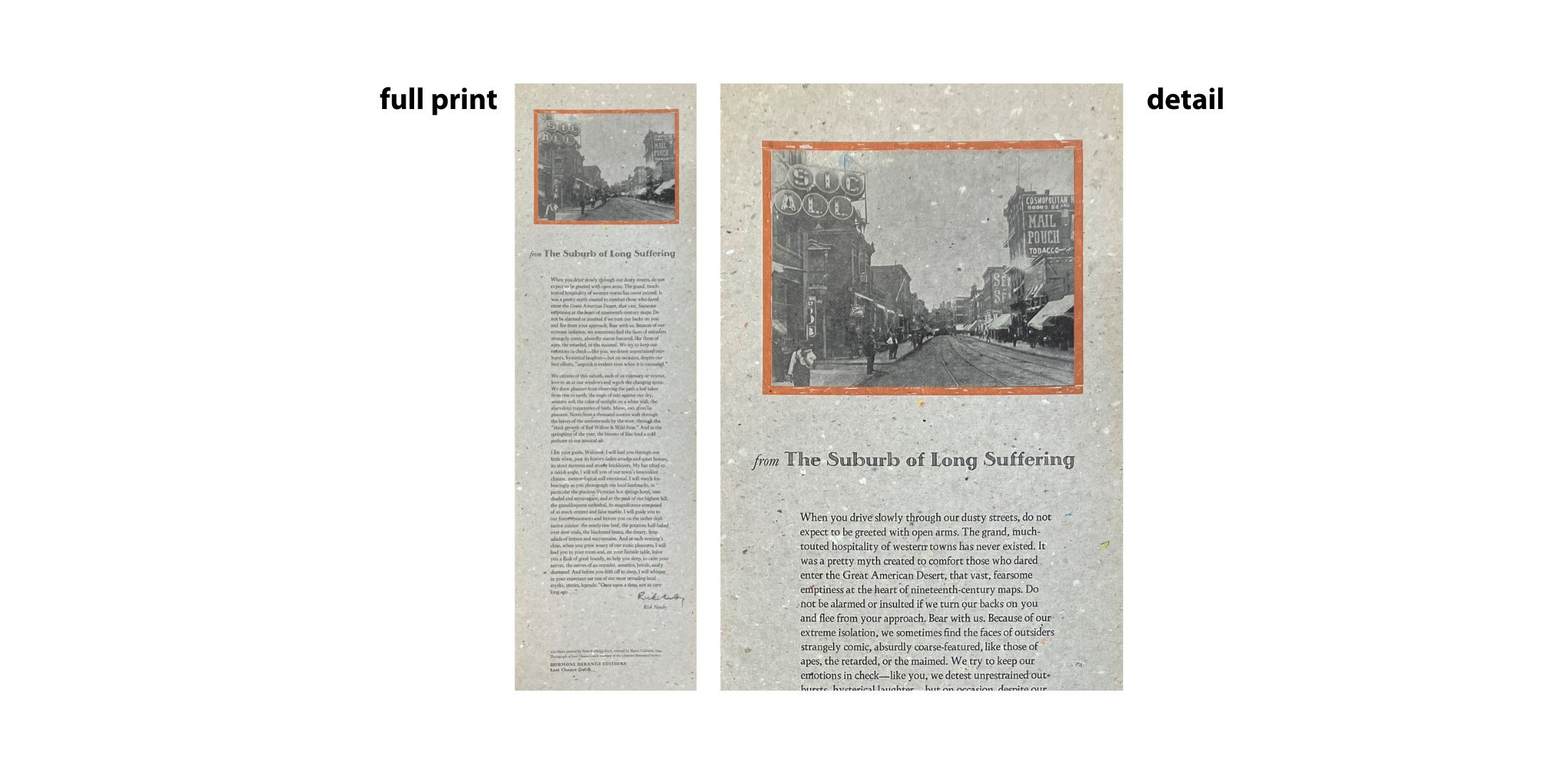From The Suburb Of Long Suffering: Rick Newby (Broadside Print)
What is a Broadside Print?
For centuries now, broadsides have been one of the most popular printed formats and disseminators of information in European and American culture. Printed on single, one-sided sheets of paper, broadsides were used to inform the public about current events and public decrees, publicize official proclamations and government decisions, announce public meetings, advocate political and social causes, advertise commercial and private products and services, and celebrate popular literary and musical efforts. Widely distributed and designed to have an immediate impact on the observer, the often richly illustrated broadsides were posted on buildings or handed out to the general population.
Printed by Peter Koch with Hormone Derange Editions, 1994.
Poem by Rick Newby.
Size: 8"x26"
Text Reads:
"When you drive slowly through our dusty streets, do not expect to be greeted with open arms. The grand, much-touted hospitality of western towns has never existed. It was a pretty myth created to comfort those who dared enter the Great American Desert, that vast, fearsome emptiness at the heart of nineteenth-century maps. Do not be alarmed or insulted if we turn our backs on you and flee from your approach. Bear with us. Because of our extreme isolation, we sometimes find the faces of outsiders strangely comic, absurdly coarse-featured like those of apes, the retarded, or the maimed. We try to keep our emotions in check-- like you, we detest unrestrained outbursts, hysterical laughter-- but on occasion, despite our best efforts, 'anguish is evident even when it is concealed.'
We citizens of this suburb, each of us visionary or voyeur, love to sit at our windows and watch the changing scene. We draw pleasure from observing the path a leaf takes from tree to earth; the angle of rain against our dry, western soil; the color of sunlight on a white wall; the marvelous trajectories of birds. Music, too, gives us pleasure. Notes from a thousand sources waft through the 'thick growth of Red Willow and Wild Rose.' And in the springtime of the year, the blooms of lilac lend a cold perfume to our musical air.
I am your guide. Welcome. I will lead you through our little town, past its history-laden arcades and quiet houses, its stout matrons and sturdy bricklayers. My hat tilted to a rakish angle, I will tell you of our town's benevolent climate, meteorological and emotional. I will watch forbearingly as you photograph our local landmarks, in particular the gracious Victorian hot springs hotel, tree-shaded and extravagant, and at the peak of the highest hill, the grandiloquent cathedral, its magnificence composed of so much cement and false marble. I will guide you to our finest restaurants and lecture you on the rather drab native cuisine: the nearly raw beef, the potatoes half-baked over slow coals, the blackened beans, the dreary, limp salads of lettuce and mayonnaise. And at each evening's close, when you grow weary of our rustic pleasures, I will lead you to your room and, on your bedside table, leave you a flask of good brandy, to help you sleep, to calm your nerves, the nerves of an outsider, sensitive, brittle, easily shattered. And before you drift off to sleep, I will whisper in your expectant ear one of our most revealing local myths, stories, legends: 'Once upon a time, not so very long ago...'"


